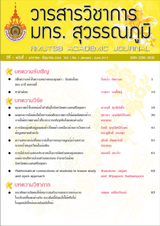ผลของการฉีดพ่นไคโตซานต่อศักยภาพการให้ผลผลิตของข้าวภายใต้สภาพขาดน้ำ ที่ระยะการเจริญเติบโตแตกต่างกัน
Main Article Content
Abstract
Effect of chitosan spraying on rice yield potential under drought stress at various growth stages
Chitosan, natural biopolymer, can be applied to trigger immune system in many plant species under abiotic stress. The objectives of this project were to 1) study effect of chitosan on rice yield potential under drought stress condition and 2) determine the most susceptible growth stage to drought resulted in yield loss. The experimental design was a split plot design and the main plot was arranged in randomized complete block with five replications. Main plot was five drought periods, including at seedling, tillering, panicle initiation, heading stage and no drought and subplot was chitosan spraying and no chitosan spraying. It was conducted at an opened greenhouse of Rajamangala University of Technology Suvarnnabhumi, during June to October 2012. The results indicated that drought stress at different growth stages showed statistically significant differences on leaf greenness, dry matter accumulation, grain yield, tiller number per plant and harvest index, however it tended that drought stress at vegetative stage (seedling and tillering stage) had more negative effects on agronomic traits (plant height, leaf greenness, dry matter, tiller number per plant) than at reproductive stage. Grain yield and translocation of assimilates (harvest index) were negatively affected by drought stress at reproductive stage (panicle initiation and heading stage). Foliar application of chitosan significantly affected leaf greenness and tiller number per plant. But the interaction between rice growth stage and chitosan application did not show any significant difference in all traits under drought stress.
Article Details
Published manuscript are the rights of their original owners and RMUTSB Academic Journal. The manuscript content belongs to the authors' idea, it is not the opinion of the journal's committee and not the responsibility of Rajamangala University of Technology Suvarnabhumi


